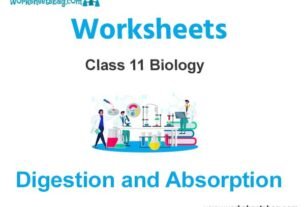Students should refer to Worksheets Class 11 Chemistry Redox Reactions Chapter 8 provided below with important questions and answers. These important questions with solutions for Chapter 8 Redox Reactions have been prepared by expert teachers for Class 11 Chemistry based on the expected pattern of questions in the class 11 exams. We have provided Worksheets for Class 11 Chemistry for all chapters on our website. You should carefully learn all the important examinations questions provided below as they will help you to get better marks in your class tests and exams.
Redox Reactions Worksheets Class 11 Chemistry
Question. The oxidation state of I in IPO4 is
(a) +1
(b) +3
(c) +5
(d) +7
Answer
B
Question. Which of the following processes does not involve either oxidation or reduction?
(a) Formation of slaked lime from quick lime
(b) Heating Mercuric Oxide
(c) Formation of Manganese Chloride from Manganese oxide
(d) Formation of Zinc from Zinc blende
Answer
A
Question. The relationship between electrode potentials and concentrations of the substances involved in half cell reaction is given by
(a) Habers process
(b) Hess Law
(c) Nernst Equation
(d) None of the Above
Answer
C
Question. Pure water is bad conductor of electricity because
(a) It has high boiling point
(b) It is almost unionised
(c) Its molecules are associated with H- bonds
(d) Its pH is 7 at 25°C
Answer
B
Question. The oxidation number of carbon in CH2 Cl2 is
(a) 0
(b) +2
(c) +3
(d) +5
Answer
A
Question. Pure water is bad conductor of electricity because
(a) It has high boiling point
(b) It is almost unionised
(c) Its molecules are associated with H- bonds
(d) Its pH is 7 at 25°C
Answer
B
Question. Burning of lime to give calcium oxide and carbon dioxide is
(a) An Oxidation Process
(b) A Reduction Process
(c) Disproportionation
(d) Decomposition.
Answer
D
Question. What is known as Autooxidation?
(a) Formation of H2O by the oxidation of H2O2.
(b) Formation of H2O2 by the oxidation of H2O.
(c) Both (1) and (2) are true
(d) None of the above
Answer
B
Question. The reduction potential values of M, N and O are +2.46 V, -1.13 V, -3.13 V respectively. Which of the following orders is correct regarding their reducing property?
(a) O > N > M
(b) M > O > N
(c) M > N > O
(d) O > M > N
Answer
D
Question. A standard hydrogen electrode has zero electrode potential because
(a) Hydrogen is easiest to oxidise
(b) This electrode potential is assumed to be zero
(c) Hydrogen atom has only one electron
(d) Hydrogen is the lightest element
Answer
B

